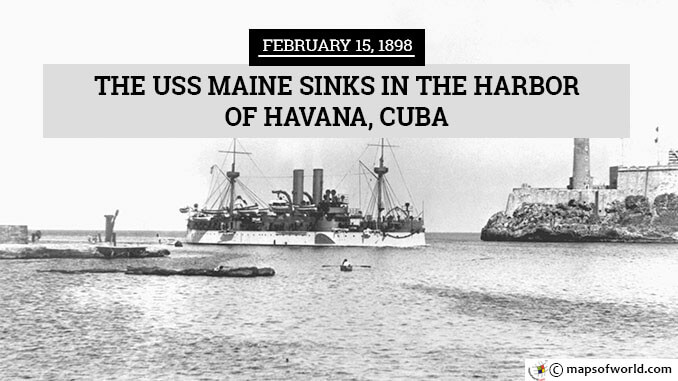At 9.40 pm February 15, 1898, the US battleship Maine exploded in the harbor of Havana in Cuban waters. The explosion tore the bottom of the ship and it sunk, killing about 260 officers and other crew members. Although it was not certain if Spain was directly responsible for the explosion, the nation was held responsible by public opinion in the US. The episode marked a low point in the relationship between the United States which was supporting the cause of Cuban independence and Spain. The escalation in tensions between the two nations led directly to the outbreak of the Spanish-American War in April that year. The USS Maine was sent to be stationed in to protect US business and military interests and support Cuba in its independence struggle against Spain. In 1897, with the Cubans breaking out in revolt, Spain had conceded Cuba limited autonomy with effect from January 1, 1898. Late January, however, witnessed much rioting and violence against Spain in Havana. Cuban rebels and Spanish forces were involved in an armed uprising and guerilla warfare that alarmed the US. American President William McKinley ordered the USS Maine to be sent to Havana in mid-January. By mid-February, the Maine had sunk. The report in the New York Times read, “As yet the cause of the explosion is not apparent. The wounded sailors of the Maine are unable to explain it. It is believed that the battleship is totally destroyed. The explosion shook the whole city. The windows were broken in nearly all the houses.” The Spanish ambassador to the United States, Don Enrique Dupuy de Lôme, was quick to deny the involvement of Spain in the explosion. He claimed that the explosion was the likely result of an accident. An inquiry and investigation committee was set up by the US Navy (Sampson Board) towards the end of March that year but there seemed to be no conclusive outcome and the cause of the explosion seemed unclear. The surviving crew member could also not point to a cause with any amount of certainty. The explosion looked like a mine detonation that had torn the ship apart. The fact that USS Maine had been at anchor and that the supposed “attack” was an unprovoked one, however, enraged the American masses. The American yellow press, particularly William Randolph Hearst of the New York Journal and Joseph Pulitzer of the New York World made use of every opportunity to write about Spanish involvement and inflame the situation. They wrote about the Spanish cruelties in Cuba and were vehemently supported by Theodore Roosevelt, the Assistant Secretary of the Navy. Many Americans responded with outrage and the slogan “Remember the Maine! To hell with Spain!” rallied the populace. President McKinley was criticized for trying to defuse the tensions. On April 11, President McKinley was compelled by public opinion to seek the permission of the Congress to send military troops to Cuba. The American Congress also authorized the use of force. On April 24, 1898, the Spanish authorities responded to the buildup of forces and declared war on the US. The United States Congress formally declared war the next day. The Spanish-American War was fought between April 25, 1898 and August 12, 1898. The Caribbean theater of war in Cuba and Puerto Rico and the Asia-Pacific theaters of Philippines and Guam were the main locations where the Spanish and American military saw action. The war was short and US secured a quick victory. In 1912, Maine’s wreck was raised to clear the harbor. The explosion of USS Maine still remains a matter of great controversy. A number of investigations were conducted apart from the US Navy’s investigation. In 1898, Spanish authorities instituted an inquiry conducted by Del Peral and De Salas. The report states that a mine could not have been the cause of explosion and points to “evidences” that debunk the mine explosion theory. These were never published by the American press at the time. The Vreeland Board of 1910 reinvestigated the incident and agreed that an external trigger caused the explosion but said that the Sampson Board had overestimated the power of the explosion. In 1976, US Admiral Hyman G. Rickover conducted a private investigation and reported that the explosion that sunk the Maine was caused by an internal factor such as a fire in the coal bunker. A National Geographic investigation in 1998 suggested that an external force such as a mine was likely but the 2002 History Channel investigation lends support to the theory of a fire in the coal bunker that spread to the powder bunker. You may also like : February 15 1946 – ENIAC is Dedicated at the University of Pennsylvania
February 15 1898 – The USS Maine sinks in the harbor of Havana, Cuba
At 9.40 pm February 15, 1898, the US battleship Maine exploded in the harbor of Havana in Cuban waters. The explosion tore the bottom of the ship and it sunk,…
1.1K
